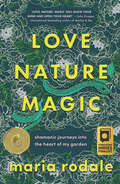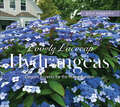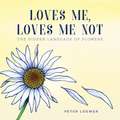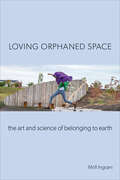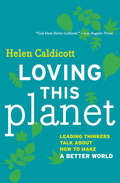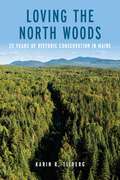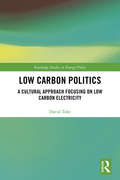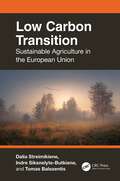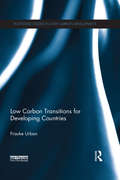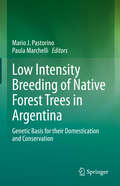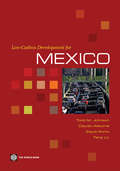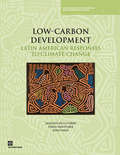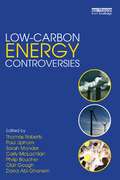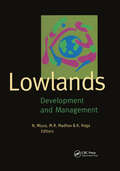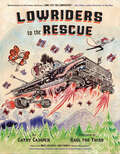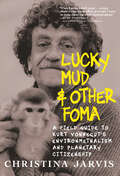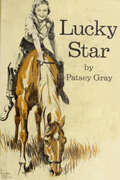- Table View
- List View
Love, Nature, Magic: Shamanic Journeys into the Heart of My Garden
by Maria RodaleA Wall Street Journal &“Best Read&”2024 Nautilus Book Award Gold Medal Winner: Nature & AnimalsJoin author, activist, and garden expert Maria Rodale as she reflects on her surprising conversations with the spirits of the familiar plants and animals around us—and the knowledge they share with us.In Love, Nature, Magic, organic advocate and former CEO of a global health and wellness company Maria Rodale combines her love of nature and gardening with her experience in shamanic journeying, embarking on an epic adventure to learn from plants, animals, and insects—including some of the most misunderstood beings in nature. Maria asks them their purpose and listens as they show and declare what they want us humans to know. From Thistles to Snakes, Poison Ivy to Mosquitoes, these nature beings convey messages that are relevant to every human, showing us how to live in balance and harmony on this Earth.Through journeys filled with surprises, humor, and foibles, follow Maria&’s evolution from resenting to accepting—and even falling in love with—our most difficult neighbors (including human ones).Maria&’s journeys include conversations with: Mugwort • Vulture • Bat • Rabbit • Lanternfly • Lightning Bug • Osage Orange • Deer • Paper Wasp • Dandelion • Tick • Groundhog • Milkweed • And more!Throughout, Maria shares an essential truth that resonates across her shamanic explorations: We first must heal our own hearts, for only then can we truly love others and begin to heal planet Earth.&“Love, Nature, Magic will blow your mind and open your heart.&”—John Grogan, author of Marley & Me&“Anyone interested in plant intelligence, and in journeying WITHOUT plant medicines, will want to read this new book.&”—Michael Pollan, author of This is Your Mind on Plants (via X)&“Maria Rodale has written a book for anyone and everyone who loves nature, the garden, and the planet. The book we didn&’t know we needed, at the time we needed it most. For comfort, for solace, for the heart and the mind.&”—Bette Midler (via X)&“Let&’s hear it for women intent on conquering new worlds—especially on the astral plane . . . [This] is a fascinating book . . . Rodale bares her soul. . . This is a journey into her heart.&”—Dominique Browning, Wall Street Journal
Loved Clothes Last: How the Joy of Rewearing and Repairing Your Clothes Can Be a Revolutionary Act
by Orsola de Castro'It's important that everyone with an interest in fashion reads this book so we can live on a healthier planet' Arizona Muse 'The most timely book you'll read this year' India Knight* * * * * Running out of space for the clothes you can't stop buying? Curious about how you can make a difference to the environmental challenges our planet faces? Join Orsola's care revolution and learn to make the clothes you love, last longer.This book will equip you with a myriad of ways to mend, rewear and breathe new life into your wardrobe to achieve a more sustainable lifestyle. By teaching you to scrutinise your shopping habits and make sustainable purchases, she will inspire you to buy better, care more and reduce your carbon footprint by simply making your loved clothes last longer.Following Orsola's practical tips to lavish care and attention on the clothes you already own will not only have a positive environmental impact, but will be personally rewarding too: hand wash, steam and spot clean your clothes, air dry instead of tumble drying, or revive your clothes by sewing or crocheting.Fast fashion leaves behind a trail of human and environmental exploitation. Our wardrobes don't have to be the finish line; they can be a starting point. We can all care, repair and rewear. Do you accept the challenge?* * * * *'An incredibly thoughtful, must-read guide' Kenya Hunt'A must read for anyone who wants to understand the fashion industry as an outsider and wants direction as to where we go next' Aja Barber
Lovely Lacecap Hydrangeas: Elegant Accents for the Home Garden
by Joan HarrisonLacecaps are the elegant form of the Hydrangea macrophylla species, popular for their sturdy, long-lasting blooms that appear delicate. They excel when massed in swaths of color, blended with companion plants, and thrive in containers and unheated spaces. Lovely Lacecap Hydrangeas: Elegant Accents for the Home Garden offers a detailed look at the best lacecap varieties, helping gardeners select plants to enhance their displays. Chapters cover • lacecap varieties, • flower color, • plant size and selection tips, • life cycle and care, • landscaping to maximize the visual impact of lacecaps, • successfully planting and caring for lacecaps, and • bringing lacecaps indoors for use in both fresh and dried flower arrangement.With over 200 color photos showcasing labeled varieties, the book provides comprehensive information on this popular segment of the hydrangea market.
Lovely Seeds: Prose to Depolarize Humanity
by R. H. SwaneyìExplores the beauty that can be found in even the most hopeless of situations.îóCyrus Parker, author of DROPKICKromanceìEvery page is a gentle reminder to take care of yourself. Lovely Seeds will help you be ok with being you.îóIain S. Thomas, author of I Wrote This For YouR. H. Swaney brings a depolarizing voice to the poetry world with this debut collection. Amongst the topics of mental health, self-love, and social progress, readers will find a soft but powerful voice that uncovers the beauty that exists inside of all of us.Examining life and its circle from seed to withering to regrowth, the thought-provoking nature of this collection will bring readers to a place of self-exploration, reflection, and a deeper understanding of their place in the world.
Loves Me, Loves Me Not: The Hidden Language of Flowers
by Peter Loewer“A single flow’r he sent me, since we met. All tenderly his messenger he chose; Deep-hearted, pure, with scented dew still wet—One perfect rose.” —Dorothy Parker Welcome to the mysterious and sometimes scandalous world of the language of flowers. Since the days of Queen Victoria (and earlier the harems of the Middle East) flowers have allowed lovers and friends to express themselves without saying a word. In Loves Me, Loves Me Not, author and illustrator Peter Loewer explores the fascinating history of floral messages. In this book you'll find intriguing plant lore, unexpected historical connections, or simply an opportunity to connect with a beloved in a unique way. Confess unrequited love with a daffodil. Show happiness with primroses. Wish someone luck with a four-leaf clover. Make your declaration of love not with a rose, but with a tulip! With intriguing stories and stunning full-color illustrations, Loves Me, Loves Me Not, introduces you to flowers that have been conveying message for centuries. As Loewer says: "The language of flowers is a delightful idea. In the world of cell phones and mass communications, sending a simple bouquet that tells a tale of love and affection seems to be a great idea whose time has come again."
Loving Orphaned Space: The Art and Science of Belonging to Earth
by Mrill IngramHow we relate to orphaned space matters. Voids, marginalia, empty spaces—from abandoned gas stations to polluted waterways—are created and maintained by politics, and often go unquestioned. In Loving Orphaned Space, Mrill Ingram provides a call to action to claim and to cherish these neglected spaces and make them a source of inspiration through art and/or remuneration. Ingram advocates not only for “urban greening” and “green planning,” but also for “radical caring.” These efforts create awareness and understanding of ecological connectivity and environmental justice issues—from the expropriation of land from tribal nations, to how race and class issues contribute to creating orphaned space. Case studies feature artists, scientists, and community collaborations in Chicago, New York, and Fargo, ND, where grounded and practical work of a fundamentally feminist nature challenges us to build networks of connection and care. The work of environmental artists who venture into and transform these disconnected sites of infrastructure allow us to rethink how to manage the enormous amount of existing overlooked and abused space. Loving Orphaned Space provides new ways humans can negotiate being better citizens of Earth.
Loving Orphaned Space: The Art and Science of Belonging to Earth
by Mrill IngramHow we relate to orphaned space matters. Voids, marginalia, empty spaces—from abandoned gas stations to polluted waterways—are created and maintained by politics, and often go unquestioned. In Loving Orphaned Space, Mrill Ingram provides a call to action to claim and to cherish these neglected spaces and make them a source of inspiration through art and/or remuneration. Ingram advocates not only for “urban greening” and “green planning,” but also for “radical caring.” These efforts create awareness and understanding of ecological connectivity and environmental justice issues—from the expropriation of land from tribal nations, to how race and class issues contribute to creating orphaned space. Case studies feature artists, scientists, and community collaborations in Chicago, New York, and Fargo, ND, where grounded and practical work of a fundamentally feminist nature challenges us to build networks of connection and care. The work of environmental artists who venture into and transform these disconnected sites of infrastructure allow us to rethink how to manage the enormous amount of existing overlooked and abused space. Loving Orphaned Space provides new ways humans can negotiate being better citizens of Earth.
Loving This Planet: Leading Thinkers Talk About How to Make A Better World
by Helen CaldicottConversations on sustainability, renewable energy, and other pressing issues: &“A level of intellectual discussion all too absent in our national discourse.&” —Booklist A co-founder of Physicians for Social Responsibility, named one of the most influential women of the twentieth century by the Smithsonian Institute, Helen Caldicott presents a valuable collection of her interviews with prominent figures and environmentalists—in which she: *Scrutinizes our unsustainable dependence on nuclear energy *Explores how the United States could transition to renewable energy *Raises awareness about issues such as deforestation and sea-level rise Extending well beyond the scope of conventional environmental discussions, this book gives us Martin Sheen on grassroots movements and unionized labor; Chris Hedges on the costs of standing up for your morals; and award-winning actress Lily Tomlin on contemporary politics, in a sarcastic and witty exchange at once hilarious and inspiring—and also includes interviews with Maude Barlow, Bill McKibben, Jonathan Schell, Daniel Ellsberg, Lester Brown, Frances Fox Piven, Bob Herbert, and more. &“A treasure trove of anecdotes featuring high-profile politicians, academics, and celebrities . . . Surprising statistics about nuclear waste storage, rising sea levels, and military spending serve as an alarm, but Caldicott and her collaborators also offer many innovative solutions.&” —Publishers Weekly &“God bless Helen Caldicott.&” —Los Angeles Times
Loving the North Woods: 25 Years of Historic Conservation in Maine
by Karin R TilbergLoving the North Woods is a chronicle of the difficult challenges that led to tremendous conservation achievements in the great North Woods of Maine. Focusing on the remarkable period of activity from 1990 to 2015, during which historic achievements in American conservation unfolded, it explores how people love a place and how they bring that love into action. The stories of conservation in Maine&’s North Woods, hidden in files of land trusts, state government archives, forest landowners&’ records, and in the memories of those who participated, can inspire and guide us now and far into the future.
Low Carbon Politics: A Cultural Approach Focusing on Low Carbon Electricity (Routledge Studies in Energy Policy)
by David TokeLow Carbon Politics focuses on how policies and institutions have influenced the deployment of renewable energy and nuclear power in the electricity sector. Cultural theory is used to analyse this. Egalitarian pressures have had a profound influence on technological outcomes, not merely in securing the deployment of renewable energy but also in increasing the costs of nuclear power. Whereas in the 1970s it might have been expected that individualist, market based pressures allied to dominant hierarchies would deliver nuclear power as the main response to problems associated with fossil fuels, a surprising combination has emerged. Egalitarian and individualist pressures are, together, leading to increasing levels of deployment of renewable energy. This work finds that electricity monopolies tend to favour nuclear power whereas competitive arrangements are more likely to lead to more renewable energy being deployed. It covers developments in a number of countries including USA, UK, China, South Africa and also Germany and Denmark. This book will be of great relevance to students, academics and policymakers with an interest in energy policy, low carbon politics and climate change.
Low Carbon Transition: Sustainable Agriculture in the European Union
by Dalia Streimikiene Indre Siksnelyte-Butkiene Tomas BalezentisLow-carbon transition is a shift from an economy that depends heavily on fossil fuels to a sustainable, low-carbon energy economy. This book analyzes the role of renewables in driving the low-carbon transition in agriculture, explores the circular bio-based economy, and examines policies and strategies designed to facilitate low-carbon transition in agriculture, greenhouse gas mitigation, and adaptation trends in the European Union agriculture sector. It provides new knowledge and understanding about the impact of low-carbon energy transition, emphasizes the key role of renewable energy in a wide range of agricultural activities, and offers alternative sustainable solutions to current practices.Features Discusses a novel approach on low-carbon transition that is not considered by the majority of studies Emphasizes the urgent need to minimize the carbon and environmental footprint of the EU agriculture and food system through low-carbon energy transition Provides theoretical background of sustainable agriculture and explains the decarbonization path of agriculture. Investigates the role of renewables, new technologies, business models, and practices in agriculture while assessing their socioeconomic and environmental effects. Presents a case study on the applications of low-carbon transition policies in selected EU member states and analyses in details various implications. This book is suitable for senior undergraduate and graduate students, professionals in agriculture, researchers, and policy makers interested in sustainable agriculture and renewable energy usage and their economics.
Low Carbon Transitions for Developing Countries (Routledge Studies in Low Carbon Development)
by Frauke UrbanGlobal climate change is one of the greatest challenges of our times and in order to tackle this carbon emissions need to be mitigated. China and India have recently become some of the world’s largest greenhouse gas emitters. Transitions to low carbon energy, for reducing emissions that lead to climate change, are therefore an urgent priority for China and India and at a global level. This is the first book focusing on low carbon energy transitions for emerging economies such as China and India, assessing the opportunities and barriers for transitions to renewable and low carbon energy as climate change mitigation options. It uses energy modelling to assess the China’s power sector, the economy of Beijing and rural Indian households that do not have access to electricity. The research evaluates the environmental, technical, socio-economic and policy implications of these low carbon transitions, concluding that they are possible in China and India and they can considerably contribute to climate change mitigation. This interdisciplinary book will be of interest to scholars, students, practitioners and policy-makers working in the fields of energy and development, energy policy, energy studies and modelling, climate policy, climate change mitigation, climate change and development, low carbon development, sustainable development, environment and development and environmental management.
Low Intensity Breeding of Native Forest Trees in Argentina: Genetic Basis for their Domestication and Conservation
by Mario J. Pastorino Paula MarchelliGlobal climate change requires the development of programs that consider the active restoration of degraded forests and the use of native trees in afforestation to preserve the natural environment. International commitments like the UN REDD program, the Montréal Process and the Convention on Biological Diversity call for the breeding of species rarely contemplated by large industrial companies. Low-intensity breeding is the most rational strategy for those species: simple but robust, and not dependent on continuously increasing funding, and therefore effective even with a relatively small budget. It commonly focuses on high genetic diversity rather than improving economic traits and adaptability rather than productivity. Controlled crosses with full pedigrees typical of high-intensity breeding are replaced by open pollination. This book presents state-of-the-art breeding strategies from the last two decades for several forest tree species of prime importance in the natural forests of Argentina. They are distributed in the three main forestry ecoregions of the country: the subtropical dry forest (Chaco), the subtropical rain forests (Yungas and Alto Paraná rainforests) and the temperate forests of Patagonia. The book also discusses the genetic patterns of the selected species defined using genetic markers together with the analysis of the variation in quantitative traits. Further, it examines the crucial features of their reproductive biology, such as the mating system and gene flow and describes the current breeding programs. Lastly, it presents the latest developments in genetic resources and their emerging applications, concluding with some reflections and perspectives related to the conditioning imposed by climate change.
Low-Carbon Development for Mexico
by Todd M. Johnson Claudio Alatorre Feng Liu Zayra RomoTo reduce the risk of climate change impacts it is necessary for the world to lower the carbon intensity of economic development. 'Low-Carbon Development for Mexico' estimates the net costs, greenhouse gas (GHG) emission reductions, and investment that would be needed to achieve a low-carbon scenario in Mexico to the year 2030. Among the key findings of the study are the following: Energy efficiency. Improving energy end-use efficiency in the industrial, residential, and public sectors is the least-cost option for reducing carbon emissions and can be achieved by accelerating current Mexican programs and policies. Supply efficiency and renewable energy. Mexico can lower the carbon intensity of the economy by improving the efficiency of energy supply in the electric power and petroleum industries, and by expanding the adoption of renewable energy technologies such as wind, biomass, small hydro, and geothermal. Public transport and vehicle fleet efficiency. Transport is the largest and fastest growing contributor of GHG emissions in Mexico, the majority of which comes from road transport. The greatest potential for reducing transport emissions lies with improving the quality and efficiency of urban transport, including more efficient vehicles and the design and organization of cities and public transport systems. Forestry - significant potential with large co-benefits. Measures to reduce emissions from deforestation and forest degradation (REDD), along with afforestation and commercial plantations, are among the largest GHG mitigation options in Mexico, and could provide numerous social and environmental benefits in rural areas. By undertaking a limited number of low-carbon interventions that are technologically and financially viable today, Mexico could hold carbon emissions relatively constant over the coming two decades while maintaining a vigorous rate of economic and social development. The costs of such a program would be relatively modest, but would require a range of regulatory and institutional changes to achieve, especially in the energy and transport sectors.
Low-Carbon Development: Latin American Responses to Climate Change
by John Nash Augusto De la Torre Pablo FajnzylberThis book, the companion volume to 'Low Carbon, High Growth: Latin American Responses to Climate Change', examines some of the major threats posed by climate change to the region's economies, societies, and biodiversity. It describes the patterns of greenhouse gas emissions in the Latin America and Caribbean region and in specific countries, finding that the future trajectory could be increases in emissions relative to other regions. 'Low-Carbon Development' explains why it is in the region's best interest to participate actively in global efforts to reduce emissions and what type of global climate change architecture could allow the countries to make their most effective contributions. Finally, the book lays out an agenda for domestic policies and investments to help the countries adapt to climate change while reducing their emissions profiles. It will be useful to policy makers, civil society organizations, and researchers working in climate change.
Low-Carbon Energy Controversies
by Paul Upham Clair Gough Sarah Mander Thomas Roberts Carly McLachlan Philip Boucher Dana Abi GhanemGovernments, big business and communities are coming under increased pressure to develop low carbon energy supply technologies. Within the context of the climate change debate a delicate balance has to be reached between local environmental protection and our need for reliable low carbon energy. This books brings together ten years of research conducted by the Tyndall Centre for Climate Change Research and uses a range of case studies from carbon capture and storage to on-shore wind farms to explore the complex nature of disputes between a wide variety of stakeholder groups. Topics covered include: the importance of context the relationship between risk and trust sense of place role of the media An invaluable resource for researchers and readers in local or national government, industry or community groups who wish to deepen their understanding of controversy around low carbon technology and how to overcome it.
Lowell Observatory: A History Of Discovery At Flagstaff (Images of America)
by Kevin SchindlerAtop a mesa one mile west of downtown Flagstaff, Arizona, sits Lowell Observatory, an astronomical research facility steeped in tradition. Percival Lowell, scion of a Boston Brahmin family, initially established his observatory in 1894 to study the possibility of intelligent life on Mars. Lowell widely popularized his controversial theories, sparking debate among both the scientific community and lay public. In the following years, the observatory's astronomers made several discoveries that dramatically altered our understanding of space, including Clyde Tombaugh's discovery of Pluto in 1930 and V.M. Slipher's detection of the expanding nature of the universe in 1912. Decades later, Apollo astronauts visited as part of their training to fly to the moon. These stories and others offer a glimpse of the scientific discovery, community pride, and personal triumph that define Lowell Observatory.
Lowlands: Development And Management
by NORIHIKO MIURA; MADHIRA R.MADHAV; KENICHI KOGAThis text presents up-to-date knowledge regarding lowlands, which are lands affected by fluctuating water levels. By collating and examining relevant information concerning lowlands in one volume, this text should be of use to engineers, planners, managers, administrators and scientists.
Lowriders to the Rescue
by Cathy CamperThe next books in the acclaimed Lowriders series combines comics, Spanish, mixing cultures, science, superheroes, and first loves for an out-of-this-world graphic novel experience.A changing planet means new problems—and new friends—for nuestros amigos favoritos!Meet Lupe, a whip-smart impala with a flair for mechanicsFlapjack, a sweet young octopus who can shine up anything with his eight gleaming tentaclesand Elirio, a thoughtful mosquito who's fascinated with words and determined to become an artist.What do all three have in common? A love of lowriders—and a passion for solving problems!Nothing is normal in the little town where the Lowriders live. To start, Flappy can't see a thing! He keeps mistaking fire hydrants for sailors and laundry for love interests. Even more worrying, the Upscale Business Association is determined to make more money than ever by tearing down local shops in favor of a brand-new development for wealthy landowners. Most disconcerting of all, the monarchs who usually migrate through town at this time of year are nowhere to be found. But when Sokar, a beautiful young monarch, bikes into town with a broken wing, she has scary news to report: A dangerous wildfire is burning fast and hot and nonstop, leaving the monarchs stranded.Might Sokar and Flappy have more in common than meets the goggles? How can the Lowriders save their town? And exactly how powerful is passion in the face of an overheated planet's furious flames?Humor, Spanish, and lowriders come together in this rollicking journey through the bumpy terrain of new friends, climate change, and standing up for what you believe in. ¡Vámonos!ACCLAIMED SERIES: Books in the Lowriders series have won the Pura Belpré award, and won the hearts of readers and reviewers. Discover why kids—and their adults—love reading about the Lowriders!PERFECT FOR RELUCTANT READERS: Bold illustrated spreads, funny storylines, and lots to look at on every page keep reluctant readers engaged all the way through these delightfully entertaining books.DIVERSE CAST OF CHARACTERS: Latinx and Arab cultures are beautifully celebrated in this book, with fascinating facts about these unexpectedly intersecting cultures.CONTEMPORARY ISSUES FOR KIDS: These books tackle so many contemporary and relevant issues. Readers will learn about monarch butterfly migrations and sustainable energy: The Lowriders refurbish their car to be solar-powered!VISUALLY DYNAMIC: Raúl's unique art style is visually refreshing and extremely engaging for kid readers, especially those who love comics and graphic novels!Perfect for:• Fans of the previous Lowriders books• Comic and graphic novel lovers• Reluctant readers• Educators and librarians looking for diverse books
Lucky (The Puppy Place #15)
by Ellen MilesIt's going to take all of seven-year-old Charles's animal smarts to get this mixed-breed puppy, whom he finds after a storm, to trust him, and all the vet's training to save him. Will this Benji look-alike be lucky enough to survive and find a home? With strong dogs and helpful puppy tips included in every book, this playful series is not only fun to read but a great resource for prospective or current junior dog owners!
Lucky (The Puppy Place #15)
by Ellen MilesSeven-year-old Charles faces a super-sized challenge when torrential rain and an injured pup take his backyard camping trip by storm. It's going to take all of Charles's animal smarts to get this mixed-breed puppy to trust him and all the vet's training to save him. Will this Benji look-alike be lucky enough to survive and find a home? With strong dogs and helpful puppy tips included in every book, this playful series is not only fun to read but a great resource for prospective or current junior dog owners!
Lucky Mud & Other Foma: A Field Guide to Kurt Vonnegut's Environmentalism and Planetary Citizenship
by Christina JarvisA fascinating deep dive into Kurt Vonnegut&’s oeuvre and legacy, illuminating his unique perspective on environmental stewardship and our shared connections as humans, Earthlings, and stardust.Vonnegut&’s major apocalyptic trio—Cat&’s Cradle, Slapstick, and Galápagos—prompt broad global, national, and species-level thinking about environmental issues through dramatic and fantastic scenarios. This book, Lucky Mud and Other Foma, tells the story of the origins and legacy of what Kurt Vonnegut understood as &“planetary citizenship&” and explores key roots, influences, literary techniques, and artistic expressions of his interest in environmental activism through his writing. Vonnegut saw writing itself as an act of good citizenship, as a way of &“poisoning&” the minds of young people &“with humanity . . . to encourage them to make a better world.&” Often that literary activism meant addressing real social and environmental problems—polluted water, soil, and air; racial and economic injustice; isolating and dehumanizing technologies; and lives and landscapes desolated by war. Vonnegut&’s remedies took many forms, from the redemptive power of the arts to artificial extended families to vital communities and engaged democracies. Reminding us of our shared connections as humans, as Earthlings, as stardust, Lucky Mud helps fans, scholars, and book lovers of all kinds experience how Vonnegut&’s writings purposely challenge readers to think, create, and love.
Lucky Star (Bright Star #4)
by Patsey GrayOrdinarily, Debbie Bell never meddled in grownups’ concerns, especially her mother’s. This was an emergency, however, for Mr. Bayly, their ranch foreman and Debbie’s good friend and mentor, had announced he was leaving — and only because Debbie’s mother had stated, finally and definitely, that she would not marry him. Whatever would they do at the Bell Ranch without Mr. Bayly’s friendly presence and extensive knowledge of horses? Not a day went by that Deb didn’t ask him for advice about training her horse, Star Bright, or about the many other problems that came up. Most of all, Deb knew how her mother relied upon Mr. Bayly and how lonely she would be with him gone. There was only one thing to do, Deb decided: play Cupid. Somehow she’d have to get her mother to change her mind and agree to marry Mr. Bayly. Deb enlisted the rather reluctant help of her best friend, Maureen, in this scheme, but nothing, not even a moonlight picnic on the mesa, seemed to change the situation. Furthermore, Deb’s mother didn’t appreciate her meddling, and Deb couldn’t bring herself to broach the other question that was uppermost in her mind: showing Star Bright in his first horse show at the fair in nearby Laurel. Deb wasn’t at all sure her mother would allow it, and in any case, how could she show Star without Mr. Bayly’s guidance? Deb finally solved her problems about both Star and Mr. Bayly, but not before some amusing, and at times frightening incidents, with an important lesson learned in the end.
Lucky on the Loose
by Betsy DuffeyThinking his owner has deserted him, Lucky escapes from the kennel, and it is up to George, stuck at baseball camp in the middle of nowhere, to find his beloved dog.
Lucky's Gold Mine (Lucky Ladd Ser. #3)
by Dean HughesStaying temporarily in snow-covered Montana, eleven-year-old Lucky gets to know a tough, angry tomboy and finds himself her only salvation when her life is in danger. Most people don't think that Lucky is really all that lucky. If there's anything slippery nearby, he'll find it and trip. His toes must have obstacle-seeking devices on them to find things to stumble over. Since his father is in a business that checks out disasters, they travel from place to place in their motor home. Lucky makes new friends at church and school, only to say good-bye to them a few weeks later. What kind of good luck is that? Ron Ladd, Lucky's father, insists that no one is luckier. Lucky manages to get through accidents that would wipe out other kids. And though he's small for his size and gets picked on, he always seems to avoid getting beat up. His luck just gets luckier when they travel to West Yellowstone in winter, where it doesn't hurt to fall down. Snow, you see, is soft. Then, on the very first day, Lucky hears about a lost gold mine from a kid named Bob. He gets to go snowmobiling and search for treasure. Eventually, they think they find their gold mine--and something else entirely different. There are over 55 more books by Dean Hughes in Bookshare's library. Three of them are about Lucky. You'll find a funny series about Nutty Nutsell and there are series about baseball, soccer, football, and soldiers. There are also some stand alone novels about boys.
